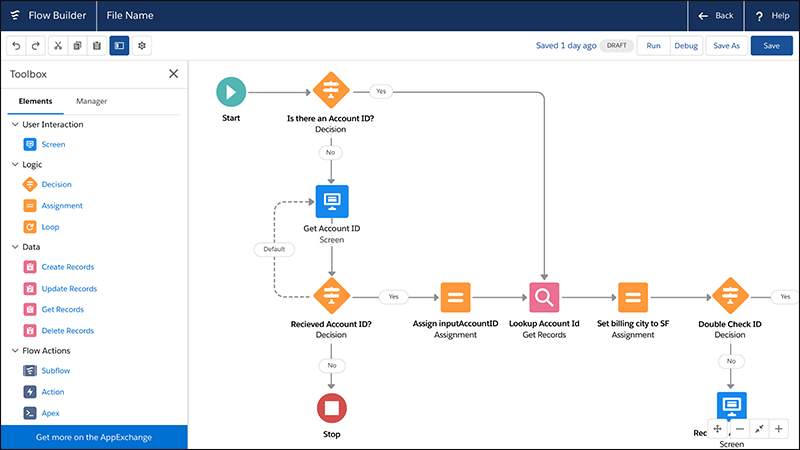Free Info On Deciding On Low-Code Platform Sites
The Advantages Of Developing Low-Code For SpeedLow-code application development significantly enhances development speed due to several important factors. Development Environment:
Drag-and-Drop Interfaces: Low-code platforms provide visual tools for designing applications. Developers can utilize drag-and-drop tools to build applications quickly without writing extensive code.
Many low-code platform come with prebuilt templates and components. This allows developers to quickly build or prototype applications without starting with a blank slate.
Coding needs that are reduced:
Automated Code Generation: The low-code platform automatically generates the code beneath based on the visual models that developers design. This reduces need for manual code coding.
Reusable Parts Developers will be able to reuse parts that are reusable across different projects, and cut down on the time required for writing and testing code.
Streamlined Collaboration:
Integrated Development Tools: Low code platforms usually include tools for testing versions, deployment and version control. They facilitate collaboration among teams.
Citizen Development (Citizen Development) User and non-developers of business applications can take part in application development by making use of intuitive interfaces. This helps to reduce the bottleneck caused by the limited access to professional developers.
Rapid prototyping, rapid iteration and rapid prototyping
Rapid Prototyping: Designers can quickly build prototypes that can be used to test ideas and gather feedback, resulting in quicker iterations.
Simple Modifications. The visual nature low-code development offers makes it easy to upgrade and modify applications. This speed up the process of improving and refining the application in response to feedback from users.
Pre-built Integrations:
API Integrations. A number of low-code platforms offer connectors that are designed to work with popular APIs and services. This can make it easier to integrate systems.
Data Integration: Built-in software to integrate data simplify the process of connecting to databases and other sources of information which speeds up the development process.
Deployment, scaling and deployment
Many low-code platforms have the option of deploying applications with one click which can reduce the amount of time and effort needed to install applications.
Cloud-based solutions: Cloud low-code platforms are capable of scaling and infrastructure management. Developers can then concentrate on functionality and logic of the application instead of deployment logistics.
Low-code development of applications is a more efficient method to create apps. It makes it easier and more efficient to automate many aspects of the process. This allows for quicker delivery and adaptation to changing requirements. View the most popular how you can help on Low-code Platform for application development for site examples including cross platform mobile dev, no code platforms, jdbc server, cross platform app development, app dev platform, cross platform app development, app modernisation, cloud software applications, rapid app development, application modernization software and more.

Low-Code Development's Cost-Effectiveness Is One Of The Primary Benefits.
Low-code application creation offers many advantages when it comes to cost-effectiveness. Companies seeking to reduce costs can benefit from this method while still delivering high-quality applications. The main benefits are reduction in development costs:
The low-code platform reduces the need for extensive manual coding. This saves time and effort of developers when developing their applications. This translates to less labor costs.
We need fewer resources for developers: Low-code programming is faster and easier which means that fewer developers with specialized skills are required. This will reduce the hiring and personnel costs.
Time to market faster:
Accelerated Development Cycle: The visual tools for development and the pre-built components offered by low-code platforms allow for rapid application development, which allows companies to get their products on market faster. This could result in faster revenue growth and better standing in the market.
Rapid prototyping. Businesses can test quickly and develop prototypes. This helps reduce time during the development phase and permits rapid iterations dependent on the feedback of users.
Low Maintenance Costs
Because of their modular design and standardised components, low-code platforms usually allow for easier maintenance of applications. This reduces the cost of maintaining the system over time.
Automated Patches and Updates: Low-code platforms are able to handle patching and updating applications in a way that is automatic. This ensures that your application remains safe and always up to date with no manual intervention.
Efficient Resource Utilization:
Contributions by Non-Developers Low-code platforms permit non-developers as well as users from the business sector to participate in the process of developing. This democratization of development processes permits firms to make use of the skills and expertise of a greater number of employees.
Utilizing IT resources efficiently IT teams can focus on strategic initiatives rather than being bogged with routine development work, improving productivity and overall efficiency.
Scalable Pricing Models
Subscription Pricing: Many platforms with low-code support different pricing options based on subscriptions that are scaled depending on the usage. This allows business to align spending with actual needs and growth while avoiding large upfront costs.
Pay-as-you-go options - Some platforms allow companies to pay for only what they use. This is particularly useful for small or new businesses with a limited budget.
Cost reductions of third-party software:
Built-in Functionalities : A low-code software often comes with built-in functionality and integrations, which eliminates the need for extra third-party tools, software and licenses.
Pre-Built Intergrations: The ability to use pre-built integrations and pre-built integrations with popular applications and systems reduces the need for custom development and saves time and money.
Improved ROI:
Improved ROI: Businesses can gain a greater return on investment from their apps by combining speedy development, lower costs and a faster times to market.
Increased Agility. Businesses can quickly adapt the demands of customers and market trends to ensure they are relevant. They can also profit from new business opportunities that come up.
Lower Cost of Training
User-friendly interfaces: Low-code platforms provide user-friendly and easy interfaces that help reduce the learning curve. They also eliminate the need for lengthy learning programs.
Accessible Resources: Many low code platforms provide complete training materials and tutorials along with community support. These resources reduce the requirement for formal instruction and the associated costs.
Streamlined collaboration:
Improved Collaboration Tools : The collaboration tools that are built into the software help in communication and coordination among team members. This results in a more efficient project development process and lower overhead.
Unified Development Environment: A single unifying development environment can help improve workflows and reduces complexities and costs associated with managing multiple tools and platforms.
The efficiency of low-code application development comes from its ability reduce development and maintainance expenses, speed up the time to market, improve resources, and provide flexible pricing models. Low-code offers substantial financial advantages to businesses. Check out the most popular Enterprise application development with Low-code Platform for website recommendations including microsoft azure sql, jdbc server, cloud software applications, stored sql procedures, push alerts, develop web application, app development platform, sso azure, develop web application, developing mobile apps and more.

Benefits Of Low-Code Application Development In Terms Of Community Support And Vendor Support
Low-code development platforms for applications can be an excellent way to get vendor support and community participation. Both of these factors are essential to ensure an effective implementation and continuous maintenance of the app. Support from the Vendor
Comprehensive Technical Support:
Support Teams: Several platforms that make use of low-code offer dedicated support teams to assist with technical problems as well as troubleshooting and advice.
Certain vendors provide 24/7 support. This is particularly beneficial to global businesses with multiple time zones.
Training and Onboarding
Structured training programs: Vendors provide structured courses such as webinars or courses for certification. This helps users quickly master the platform.
Personalized Onboarding: Many companies offer personalized onboarding to assist new customers to use the platform efficiently and adapt it to their specific requirements.
Regular Updates, Enhancements, and Improvements:
Continuous Improvement: Low code platform providers regularly release updates that include updates to features, security patches and enhancements to performance. This helps ensure that the platform is always current and safe.
Feedback Integration: Vendors include feedback from users into their design cycles to ensure the platform is evolving to meet the evolving needs of its users.
Comprehensive Documentation:
Documentation is detailed: Users are usually able to access a wealth of well-organized documents that range in terms of complexity from basic customization to advanced.
API References Comprehensive API documentation allows developers to modify applications and connect low-code platforms with other platforms.
Professional Services and Consulting
Expert Consulting : Vendors provide consultancy services, including the design of architectures and complicated implementations. They do this to ensure that users are able fully benefit from the platform.
Custom Development Services: Certain companies provide custom development services to develop specific features or integrations that are not included in the default.
Community Support
Active User Groups:
Discussion boards and forums Forums and discussion boards: Many platforms that are low-code feature a vibrant community where users can seek help, share solutions, and work together to discover the most effective methods.
Meetups and User Groups User Groups and Meetups: Local or virtual group and meetings are a great opportunity to network, learn and sharing your experiences.
Collaboration and Knowledge Sharing
Community-Contributed Resources: Users often share templates, modules, and extensions that they have developed, which can be reused or adapted by others, accelerating development and innovation.
Crowdsourced Problem Solving: The collective knowledge and experience of the community can be a great source for identifying issues and finding creative solutions to difficult problems.
Learning and development:
Community-Led training: Many communities offer webinars, workshops, and training sessions facilitated by experienced users.
Online Tutorials and Courses: Members of the community create and share tutorials, online courses and guides on how to use. This enhances the learning resources that are accessible to all users.
Feedback and Influence
Forums for Product Feedback Community forums include many channels to provide feedback to vendors, which can influence the design of new features.
Beta Testing Programs: Members of active communities may have the opportunity to take part in beta testing programs, giving them early access to new features and an opportunity to participate in influencing the evolution of the platform.
Recognition and Encouragement
Many companies offer community recognition programs. These programs reward active community members, and can include MVP programs.
Peer support: Community members are often willing to offer peer-support, offering their expertise and advice to those less familiar. They help create a supportive environment by fostering collaboration and a supportive atmosphere.
The overall result of a solid vendor with active, engaged communities provide an extensive environment to support of low-code applications development. Users will be able get the help, resources, and collaboration opportunities they need to build, deploy, maintain and improve their applications.
